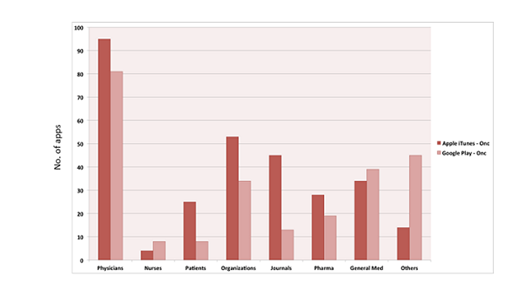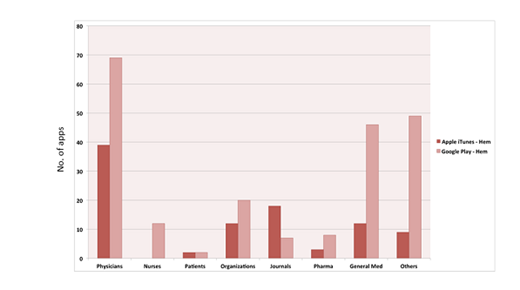In the last few years, there has been a tremendous increase in the availability of smartphones, tablets, and computers in the United States and worldwide. Smartphones are the most commonly used personal computer and have revolutionized the communication landscape in our personal and professional lives. These portable handheld devices can provide real-time, on-demand communication and deliver data services anywhere in the world, provided that there is an available Internet connection.
In the current rapidly growing technology era, there are opportunities to develop high-quality, standardized, and cost-effective health-related assessment and educational tools, which has led to the development of a growing area of health science research, known as mobile health, or mHealth. The National Institutes of Health (NIH) Consensus Group defines mHealth as “the use of mobile and wireless devices to improve health outcomes, healthcare services and health research.”1
Mobile health market trends have estimated that 500 million smartphone users worldwide, including health-care professionals and patients, will be using a health-care application by 2015.2 By 2018, the number of users could rise to more than 3.4 billion. In 2012, the Association of American Medical Colleges (AAMC) reported on the rapid growth of health-related smartphone applications.3 A survey of training programs by the ACGME (Accreditation Council for Graduate Medical Education) showed that more than 85 percent of trainees used a smartphone, and more than 50 percent of them reported daily use of mobile applications.4 These data raise some basic questions: what are the demographics of smartphone use for health-related apps? Which hematology and oncology apps are available in the marketplace? How much control do we have over the quality of the content? What are the implications for our patients?
Badawy Apps Feature graph1
Smartphone Ownership and Accessibility to Health Information
As of January 2014, the Pew Research Center reported that 58 percent of all adults in the United States have owned a smartphone. Ownership was slightly more common in males (61%) than females (57%). The majority of African Americans (59%), Hispanics (61%), and Whites (53%) owned a smartphone.5 Smartphone ownership was directly related to educational levels and household incomes, but it was inversely related to age. Smartphone owners (52%) were more likely to gather health information on their phones when compared with non-owners (6%).6 Individuals who recently had a medical emergency or an important change in their physical health were more likely to use their own phones to look for health information. Additionally, smartphone owners and women aged 30 to 64 years are more likely to sign up to get health text alerts. While smartphones enable individuals to use different apps to help monitor and manage their health, only 19 percent of smartphone owners have at least one health app on their phone, with exercise, diet, and weight apps being the most common.
Badawy Apps Feature graph2
Hematology and Oncology Apps Available
We searched both Apple iTunes and Google Play for apps using “hematology” and “oncology” as keywords. We found a total of 545 oncology apps at Apple (298) and Google (247), and 308 hematology apps at Apple (95) and Google (213). Based on target audience, purpose, and other characteristics, we categorized apps into eight different groups (see online Figure). “Physician” apps comprised the majority and included clinical guidelines, cancer staging, educational materials, imaging tools, and laboratory references. Apps classified as “Others” included those in non-English languages, those that are nonmedical, and/or those with unclear purposes. Only a minority of hematology and oncology apps were disease-specific, and most journals in the field had more apps available in Apple iTunes. Hematology or oncology disease-specific search terms could have resulted in more apps, but that was beyond the focus of this article. Some popular hematology and oncology apps are summarized in the Table.7-9
Table. Popular Hematology and Oncology Apps
| App Name . | Platform . | Developer . | Purpose . | Comments . |
|---|---|---|---|---|
| Miniatlas Hematology | iOS | EC-Europe | Patient education | Good-quality detailed medical illustrations that can be emailed to patients. |
| Hematology Outlines | iOS | Dr. Hooman H. Rashidi and Dr. John C. Nguyen | Medical education | Multiple interactive options showing normal and abnormal hematologic entities; atlas, and glossary components. |
| CancerRx | iOS | MedPage Today and CollabRx | Clinical decision support | Physicians can enter patient data and receive a list of suggested therapies with references from UpToDate website. |
| Calculate by QxMD | iOS, Android | QxMD Medical Software Inc. | Calculations and formulas | Includes hematology and oncology specialties; physicians can enter data to derive disease-specific staging results and prognostic scores. |
| PubMed on Tap | iOS | ReferencesOnTap | Journal articles | Users can search PubMed and PubMed Central, as well as their library's collection after entering an organization or university's unique proxy URL in the app's settings. |
| NCCN Guidelines® / NCCN Guidelines® for Smart phone | iOS, Android | National Comprehensive Cancer Network | Guidelines and reimbursement resource | Guidelines are listed in alphabetical order; icons for chosen guidelines can appear on the homepage. Physicians, patients, or payers can view and download content. |
| inPractice for Specialists | iOS, Android | Clinical Care Options | Clinical decision support | Includes a search interface that is able to retrieve results in three main buckets: Guidelines, PubMed, and Clinical Trials. |
| App Name . | Platform . | Developer . | Purpose . | Comments . |
|---|---|---|---|---|
| Miniatlas Hematology | iOS | EC-Europe | Patient education | Good-quality detailed medical illustrations that can be emailed to patients. |
| Hematology Outlines | iOS | Dr. Hooman H. Rashidi and Dr. John C. Nguyen | Medical education | Multiple interactive options showing normal and abnormal hematologic entities; atlas, and glossary components. |
| CancerRx | iOS | MedPage Today and CollabRx | Clinical decision support | Physicians can enter patient data and receive a list of suggested therapies with references from UpToDate website. |
| Calculate by QxMD | iOS, Android | QxMD Medical Software Inc. | Calculations and formulas | Includes hematology and oncology specialties; physicians can enter data to derive disease-specific staging results and prognostic scores. |
| PubMed on Tap | iOS | ReferencesOnTap | Journal articles | Users can search PubMed and PubMed Central, as well as their library's collection after entering an organization or university's unique proxy URL in the app's settings. |
| NCCN Guidelines® / NCCN Guidelines® for Smart phone | iOS, Android | National Comprehensive Cancer Network | Guidelines and reimbursement resource | Guidelines are listed in alphabetical order; icons for chosen guidelines can appear on the homepage. Physicians, patients, or payers can view and download content. |
| inPractice for Specialists | iOS, Android | Clinical Care Options | Clinical decision support | Includes a search interface that is able to retrieve results in three main buckets: Guidelines, PubMed, and Clinical Trials. |
Potential Benefits
Mobile devices and health-related apps offer many benefits to health-care providers, trainees, and patients. Some medical apps utilize innovative interactive platforms with searchable clinical resources for better, more personalized learning experiences. Other common uses among health-care providers include drug referencing, clinical decision-support, communication with patients or other colleagues, and access to electronic health records and medical education materials.10 Additionally, there are several apps that help patients to self-manage their lifestyle, specifically weight and exercise. Users can also track a chronic condition and even report symptoms to their health-care providers. Therefore, mobile apps use can facilitate bidirectional physician-patient communication in different settings.
Worrisome Risks
The wide use of health-related apps may bring benefits, but it also carries risks. The main concerns have been related to safety, accuracy, and reliability. Medical professionals were involved in the design and development of only one third of more than 160 apps evaluated.11-12 Concerns about patient safety, accountability, and the quality of the app content persist. For example, there are multiple apps to help with opioid conversion calculations, but inconsistencies were found in 23 such apps evaluated, which could have serious consequences.12 In addition, an app developed to identify and manage skin cancer was found to be accurate in identifying only 11 percent (10 of 93) of high-risk melanoma cases when tested against images from the National Cancer Institute and Fitzpatrick’s Dermatology in General Medicine,13 urging caution against apps with poor diagnostic accuracy in high-risk serious diseases, including cancer. Low health literacy and numeracy add to the complexity of safely utilizing health-related apps.
Privacy, Security, Licensure, and Malpractice Considerations
There are some legal implications that come with the growing interest in adopting health-related apps on a broader scale. Legal guidance for health-care providers and app developers is critical to ensuring that regulations are followed and unforeseen pitfalls are avoided.14 Advances in the technological landscape outpace newly developed legal protections, and maintaining the privacy of patients’ health information with the use of health-related apps represents a challenge. Although Health Insurance Portability and Accountability Act (HIPPA) privacy protections have been effective in securing individually identifiable health information since its enactment in 1996, they may not apply to every situation in health-related apps.15 HIPPA privacy rules apply to any health-care provider that transmits health-care information electronically and uses health-related apps within a health-care setting.16 Additionally, the privacy of data collected by health apps and stored on smartphones or tablets is threatened by the risk of a data breach if a device is lost or stolen. Application-specific passwords as well as device safeguard mechanisms, such as authentication and encryption, are necessary to secure sensitive patient data.
The regulation of cross-jurisdictional licensing, as it relates to how health-care providers use health apps to communicate and share patient information with other providers across state lines, is still unclear.14 Furthermore, physicians’ adoption of health apps for patient care as well as their recommendations for patient use have been guarded with concerns for malpractice liability, which may or may not be different from other already adopted technologies. However, with growing reliance on health apps, their use may become standard of care, especially if proven effective. Although developers of private health apps have full control of app content and functionality, they are generally not at risk for malpractice claims, but other liability issues could apply, including design defect, breach of warranty, and failure to warn.
FDA Regulations for Health-Related Apps
The U.S. Food and Drug Administration (FDA), which has oversight of mobile medical apps, has issued guidance based on risk and functionality.17 The FDA’s focus is primarily on apps that present a greater risk to patients if they do not work as intended, and on apps that cause smartphones or other mobile platforms to interfere with the functionality or performance of traditional medical devices. The FDA has chosen a more tailored and focused approach to the regulation of mobile medical apps and, by adopting more of a guiding role, encourages and supports new innovative technologies. The FDA has no intention of requiring manufacturers to apply for FDA approval, register their company, or list their devices in the FDA’s database.18
Conclusion
Health-related apps have their potential benefits, harms, and limitations. Additional studies are warranted to evaluate the clinical benefits and cost effectiveness of health-related apps. Legal concerns related to app use need to be addressed with clearer regulations. Policing and tracking every single app developed is not feasible, but a more viable approach might be to educate users about the potential risks of the use of apps and to provide strategies to evaluate the quality of apps before downloading them on their personal devices. With these issues addressed, further adoption of mHealth technology by patients and providers will change the landscape and practice of fields such as hematology and oncology.
References
Competing Interests
Dr. Badawy, Dr. Liem, and Dr. Thompson indicated no relevant conflicts of interest.


